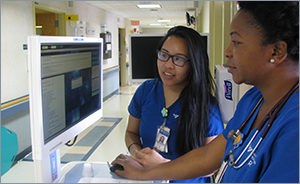-
Services
Featured Specialties
-
Locations
Location Type
-
Patients & Visitors

The Saint Raphael Campus has joined the York Street Campus in implementing Transforming Patient Care (TPC) — a process improvement effort that focuses on patient safety, as well patient satisfaction and operational efficiencies.
"Transforming Patient Care incorporates the principles of patient- and family-centered care and service excellence/patient experience into everyday nursing practice," said Jadine Small, team leader, YNHH Internal Consulting Group. "The goals are to improve patient safety and the patient experience, nursing workflow and employee engagement, along with teamwork and communication." Additionally, the operational and clinical efficiencies should result in cost savings for the hospital.
While many SRC units had previously implemented elements of the TPC program, the goal is to ensure that all nurses, clinical technicians (CTs) and patient care associates (PCAs) consistently follow TPC protocols, said Kathleen Merwin, RN, team leader, YNHH Internal Consulting Group. Merwin and Small are working with Lori Hubbard, RN, nursing clinical operations coordinator, to implement the initiative at the SRC.
TPC components include safety huddles at 7 am and 7 pm; nurse to CT/PCA reports first thing in the morning; hourly nurse and CT/PCA rounds; and twice daily manager schedule checks.
To ensure safe patient handoffs at shift change, the departing nurse reports to the oncoming nurse using the SBAR (situation, background, assessment, recommendation) HRO safety technique, and both nurses meet with the patient to share information and perform safety checks.
To ensure the most current information is immediately available to all members of the care team, workstations on wheels are used for real-time, bedside documentation of patients' medications, assessments, interventions, vital signs and other information.
TPC also includes components to minimize disruptions that can lead to errors. CTs/PCAs round to assist patients with their needs while nurses are giving report to one another; and medication safety "quiet zones" around Pyxis machines help prevent interruptions that can lead to medication errors.
TPC also seeks to involve patients more in their care. Nurses and patients work together to establish patients' daily goals, which are posted on new white boards in patient rooms.
"TPC, with standardized work processes and improved information technologies, will provide nursing staff with more time to spend at the patient's bedside," said Diane Vorio, RN, vice president, Patient Services, and associate chief nursing officer. "As an outcome, our patients and families will be highly engaged in their plan of care and have increased satisfaction with staff teamwork and their overall experience."
"Our nurses, clinical technicians and patient care associates are compassionate and well trained and work hard to ensure that they deliver exceptional patient care," said Sue Fitzsimons, RN, PhD, senior vice president, Patient Services, and chief nursing officer. "TPC is no longer an initiative — it is the way we care for patients at YNHH."